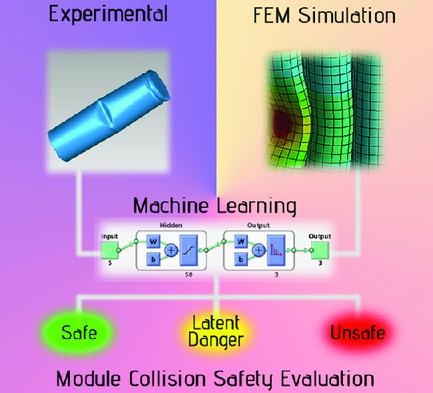当前位置:
X-MOL 学术
›
Energy Technol.
›
论文详情
Our official English website, www.x-mol.net, welcomes your feedback! (Note: you will need to create a separate account there.)
An Intelligent Deformation‐Based Approach to the State of Health Estimation of Collided Lithium‐Ion Batteries for Facilitating Battery Module Safety Evaluation
Energy Technology ( IF 3.8 ) Pub Date : 2020-09-21 , DOI: 10.1002/ente.202000624 Jian Zhang 1, 2 , Xiangyang Liu 1 , Chunrong Chen 1 , Alessandro Simeone 1
Energy Technology ( IF 3.8 ) Pub Date : 2020-09-21 , DOI: 10.1002/ente.202000624 Jian Zhang 1, 2 , Xiangyang Liu 1 , Chunrong Chen 1 , Alessandro Simeone 1
Affiliation

|
With the increasing trend of electric vehicles sales, the awareness for safety issues in energy storage systems has seen a rapid growth. In this context, literature predominantly focuses on the assessment of lithium‐ion battery cell State of Health (SoH) under regular operating conditions. An interesting gap is highlighted by scarce contributions with reference to the SoH in case of collision impacts. This paper proposes a method for estimating the battery cell SoH from collision deformation features via finite element (FE) simulation. An experimental series of collision impact tests is performed on battery cells to study deformation features. A 3D scanning procedure is performed on the cells to retrieve the geometrical features. The cells damage evaluation is carried out by considering physical and electrical performances. The SoH classification is modeled as a machine learning–based pattern recognition enabled by Artificial Neural Network (ANN) trained with deformation features and classifying cells into safe, latent danger, and unsafe cells respectively. Utilizing such pattern classifier, a FE approach is used to conduct an impact simulation on a battery module. In this respect, the deformation features obtained via simulation are input into the ANN pattern classifier experimentally trained to predict the cells SoH within the module.
中文翻译:

基于智能变形的锂离子电池碰撞健康状态估计方法,以促进电池模块安全性评估
随着电动汽车销售的增长趋势,对储能系统中安全问题的认识迅速增长。在这种情况下,文献主要侧重于在正常工作条件下评估锂离子电池芯的健康状态(SoH)。在碰撞影响的情况下,与SoH有关的稀缺贡献突出了一个有趣的空白。本文提出了一种通过有限元(FE)仿真从碰撞变形特征估计电池单元SoH的方法。对电池单元进行了一系列实验性的碰撞冲击测试,以研究变形特征。对单元执行3D扫描过程以检索几何特征。通过考虑物理和电性能来进行细胞损伤评估。SoH分类被建模为一种基于机器学习的模式识别,该模型由人工神经网络(ANN)进行训练,该神经网络接受了变形特征训练,并将单元分别分为安全,潜在危险和不安全单元。利用这种模式分类器,可以使用有限元方法对电池模块进行冲击仿真。在这方面,将通过仿真获得的变形特征输入到经过实验训练的ANN模式分类器中,以预测模块中的单元格SoH。
更新日期:2020-11-06
中文翻译:

基于智能变形的锂离子电池碰撞健康状态估计方法,以促进电池模块安全性评估
随着电动汽车销售的增长趋势,对储能系统中安全问题的认识迅速增长。在这种情况下,文献主要侧重于在正常工作条件下评估锂离子电池芯的健康状态(SoH)。在碰撞影响的情况下,与SoH有关的稀缺贡献突出了一个有趣的空白。本文提出了一种通过有限元(FE)仿真从碰撞变形特征估计电池单元SoH的方法。对电池单元进行了一系列实验性的碰撞冲击测试,以研究变形特征。对单元执行3D扫描过程以检索几何特征。通过考虑物理和电性能来进行细胞损伤评估。SoH分类被建模为一种基于机器学习的模式识别,该模型由人工神经网络(ANN)进行训练,该神经网络接受了变形特征训练,并将单元分别分为安全,潜在危险和不安全单元。利用这种模式分类器,可以使用有限元方法对电池模块进行冲击仿真。在这方面,将通过仿真获得的变形特征输入到经过实验训练的ANN模式分类器中,以预测模块中的单元格SoH。



























 京公网安备 11010802027423号
京公网安备 11010802027423号